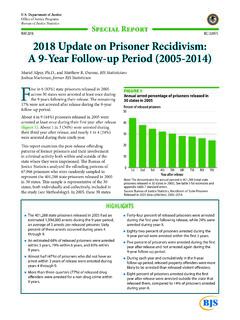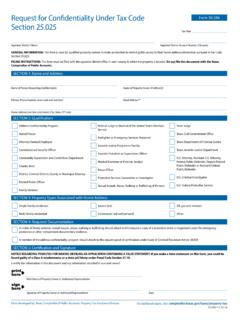Transcription of September 1994, NCJ–149286 Fact Sheet: Drug-Related Crime
1 Drugs & Crime Department of JusticeOffice of Justice ProgramsBureau of Justice StatisticsSeptember 1994, NCJ 149286D E P A R T M E N T O F J U S T I C E O F F I C E O F J U S T I C E P R O G R A M S B J A N I J O J J D P B J S O V C Fact Sheet: Drug-Related CrimeDrugs are related to Crime in multiple ways. Mostdirectly, it is a Crime to use, possess, manufacture, ordistribute drugs classified as having a potential for , heroin, marijuana, and amphetamines areexamples of drugs classified to have abuse are also related to Crime through the effects theyhave on the user s behavior and by generating violenceand other illegal activity in connection with drug traffick -ing.
2 The following scheme summarizes the various waysthat drugs and Crime are product of the Drugs & Crime Data Center & Clearinghouse1 800 666 3332 Summary of drugs/ Crime relationshipDrugs andcrimerelationshipDefinition ExamplesDrug-definedViolations of lawsDrug possession oroffensesprohibiting or reg-use. Marijuanaulating the possession,cultivation. Metham-use, distribution, orphetamine ofCocaine, heroin, orillegal in which aViolent behavioroffensesdrug s pharmacologicresulting from drugeffects contribute;effects.
3 Stealingoffenses motivated byto get money tothe user s need forbuy drugs. Violencemoney to supportagainst rival drugcontinued use; connectedto drug use and crimeA life orientationlifestyleare common aspectswith an emphasis onof a deviant goalsThe likelihood andsupported by illegalfrequency of involve-activities. Opportuni-ment in illegalties to offend resultingactivity is increasedfrom contacts withbecause drug usersoffenders and illegalmay not participatemarkets. Criminalin the legitimateskills learned fromeconomy and areother to situationsthat encourage fact sheet will focus on the second and third catego-ries.
4 Drug-Related offenses and a drug-using lifestyle aremajor contributors to the Crime users in the general population are morelikely than nonusers to commit crimesThe Department of Health and Human Services(HHS) National Household Survey on Drug Abuse asksindividuals living in households about their drug andalcohol use and their involvement in acts that could getthem in trouble with the police. Provisional data for 1991show that among adult respondents (ages 18 49), thosewho use cannabis (marijuana) or cocaine were much morelikely to commit crimes of all types than those who didTable 1.
5 Criminal behavior and substance useamong 18- to 49-year-olds, 1991 provisional data Percent reporting alcohol and drug use inpast yearGotdrunkAlcohol,Alcoholmonthlycannab is,and(no CriminalandcannabisillicitAlcohol activitycocaine*only*drug use)only NoneAny underthe * Indicates use of each of these substances some time duringthe past year, not necessarily use of both/all at the same : Harrison & Gfroerer, inmates1991 Youth in custody1987 Sources: BJS, Drugs and jail inmates, 1989; BJS, Survey ofState prison inmates, 1991; BJS, Survey of youth in custody,1987not use these substances (table 1).
6 Of those reporting useof alcohol, cannabis, and cocaine during 1991, alsoreport that they committed violent crimes during the Bureau of Justice Statistics (BJS) National CrimeVictimization Survey (NCVS) asks the victims of violentcrimes who reported seeing the offender whether theyperceived the offender to be under the influence of drugsor alcohol. According to the 1992 survey, about half thevictims could not determine whether the offender wasunder the influence of a substance. Of those who couldmake a determination, about 59% reported that the offen-der was under the influence of alcohol and/or drugs.
7 Themost common substance identified was alcohol notcombined with other drugs. About 20% reported thatoffenders were under the influence of drugs alone or incombination with frequently test positive for recentdrug useThe National Institute of Justice (NIJ) Drug Use Forecast-ing (DUF) Program measures drug use among arresteesby calculating the percentage of individuals with positiveurine tests for drug use. DUF data are collected voluntar-ily and anonymously at the time of arrest from arrestees inbooking facilities in selected collected from male arrestees in 1992 in 24 citiesshowed that the percentage testing positive for any drugranged from 42% to 79% across the cities.
8 Positive drugtests for females arrested ranged from 38% to 85%. Malearrestees charged with drug sale/possession were themost likely to test positive for drug use. Female arresteescharged with prostitution or drug sale/possession werethe most likely to test positive (table 2). Both males andfemales arrested for burglary and robbery had highpositive offenders were often under theinfluence of drugs when they committed theiroffensesSentenced jail and prison inmates were asked whetherthey were under the influence of drugs or drugs andalcohol at the time they committed the offense thatresulted in their incarceration.
9 The percentage of jail andprison inmates who reported they were under the influ-ence of drugs at the time of the offense varied across themajor offense categories. The 1991 BJS Survey ofInmates in State Correctional Facilities found that drugoffenders, burglars, and robbers were the most likely toreport having been under the influence of drugs. Prisoninmates convicted of homicide, assault, and public orderoffenses were among those least likely to report beingunder the influence of drugs. The 1989 BJS Survey ofInmates in Local Jails shows a similar pattern (figure 1).
10 OfoffendersFigure 1. Offenders reporting being under theinfluence of drugs or drugs and alcohol at the timeof the offenseTable 2. Drug use by booked arrestees in 24selected cities, by charge at arrest, 1991 Percent testing positiveChargeMalesFemalesDrug sale/possession79%79%Burglary6863 Robbery6576 Larceny/theft6458 Probation/parole violation6160 Stolen property5874 Fraud/forgery56%51%Fight/escape/warrant5 266 Other5146 Weapons4962 Public peace/disturbance4861 Homicide4865 Assault48%50%Prostitution4785 Damage/destruction of property4557 Traffic offense4248 Family offense4038 Sex offense3768 Note: Positive by urinalysis.












![[PUBLISH] In the United States Court of Appeals](/cache/preview/a/4/3/7/d/9/4/e/thumb-a437d94e29a8e141627f78b4b6b1a92c.jpg)


